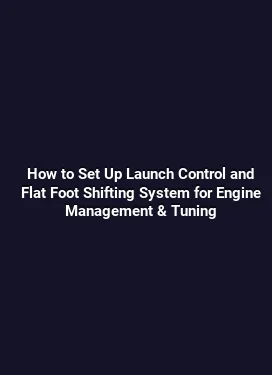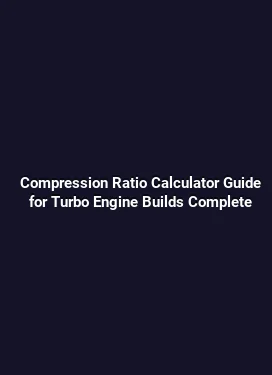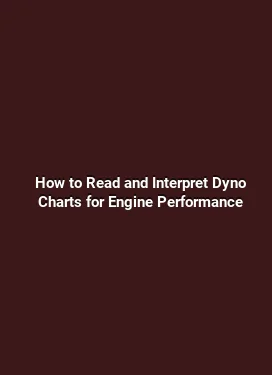Engine Balancing Cost vs Performance Benefits: Is It Worth It?
Understanding the Core Trade-Offs: Cost, Benefit, and Behavioral Changes

Engine balancing, in the context of performance tuning, is a multi-faceted endeavor that touches mechanical wear, efficiency, throttle response, and overall power delivery. The central question is not merely about chasing peak horsepower, but about aligning the investment with tangible gains in drivability, reliability, and long-term value. When evaluating cost versus benefit, it is essential to distinguish between upfront expenses, ongoing maintenance considerations, and the measurable performance outcomes across real-world driving scenarios.
At its essence, balancing a performance engine involves optimizing rotating assembly tolerances, ignition timing, fuel delivery, and air management to harmonize all systems. This harmonization can yield smoother engine operation, more precise power delivery, and improved efficiency under varied load conditions. The economic side of the equation includes parts, labor, dyno validation, and potential ancillary upgrades such as cooling enhancements or exhaust refinements. The question becomes how these elements translate into meaningful results for street, track, or mixed-use applications.
The Anatomy of the Balancing Process: What Investors Typically Fund
Engine balancing is not a single adjustment but a coordinated sequence of refinements. The initial phase usually involves a thorough assessment of mechanical tolerances: crankshaft runout, rod bearing clearances, piston-to-wall interactions, and ring seating. These measurements establish the baseline from which gains are quantified. Following this, dynamic tuning elements—such as ignition timing maps, fuel trims, and air metering—are fine-tuned to the engine’s specific breathing characteristics and fuel quality. Each step carries its own cost vector, and the cumulative effect determines the overall value proposition.
From a cost perspective, a comprehensive balance can include precision machining, hardware upgrades (like lighter pistons or forged rods), and high-precision calibration on a dynamometer. Labor charges vary by region, shop expertise, and whether the work includes supplementary improvements such as intercooling, exhaust optimization, or intake plenums. It is common to see a staged approach: a fundamental balance combined with a conservative tuning baseline, followed by incremental refinements as data is gathered during road testing and track sessions.
Quantifying Performance Gains: What Realistic Improvements Look Like
Performance gains from engine balancing are highly context-dependent. For naturally aspirated setups, benefits often manifest as improved throttle response, a broader and more usable power band, and smoother torque delivery. In forced induction systems, balancing can unlock more aggressive timing strategies and more efficient intercooling behavior, potentially increasing peak power and maintaining safer detonation margins under higher boost. The key is to translate these gains into repeatable, measurable outcomes rather than isolated peak numbers.
Realistic expectations should consider dyno results, track times, and driveability metrics. A well-balanced engine may show modest gains in peak horsepower but a more significant improvement in horsepower under mid-range loads, which translates to quicker acceleration in everyday driving. Additionally, improved mechanical harmony often reduces fatigue on components such as bearings, pistons, and connecting rods, contributing to long-term reliability and potentially lower maintenance costs over time.
Driveability and Responsiveness: The Practical Benefits

One of the most tangible benefits of proper balancing is enhanced driveability. A smoother idle, more consistent fueling windows, and a more linear power curve contribute to a more confident driving experience. For performance-focused builds, this translates into improved launch characteristics, quicker shifts under load, and more predictable throttle application on corner exits. The result is a more enjoyable and controllable vehicle, especially in dynamic driving environments.
From a tuning perspective, driveability improvements often come from harmonizing ignition timing with fuel delivery across RPM ranges. This synchronization reduces timing stalls or misfires that can occur when components wear unevenly or when tolerance stacks exceed design margins. The net effect is a vehicle that behaves predictably under a range of conditions, which is highly valued by both enthusiasts and professionals testing in varied environments.
Cost Components: Where the Budget Is Allocated
Upfront hardware costs can include precision components such as lightened rotating assemblies, forged pistons, performance bearings, and sometimes upgraded valve train parts. The selection depends on whether the goal is improved durability, reduced rotating inertia for high-revving applications, or enhanced sealing under elevated pressure scenarios. Labor costs reflect the complexity of the engine architecture and the precision required during teardown, measurement, and reassembly. In some cases, additional upgrades—such as improved cooling, upgraded fuel pumps, or more capable intake and exhaust systems—become part of the package to maintain reliability at higher performance levels.
Operational costs after tuning encompass regular maintenance checks, more frequent fuel quality assessments, and potential recalibrations if fuel blends or altitude conditions vary significantly. It is common for owners to schedule periodic dyno sessions or road tests to ensure that the tuning remains aligned with current hardware conditions and environmental factors. The long-term financial picture, therefore, blends initial expenditure with the value of reliability, reduced downtime, and enhanced driving satisfaction.
Assessing Return on Investment: A Practical Framework
To evaluate ROI, consider three axes: performance, reliability, and daily usability. Performance quantification can be anchored to dyno horsepower and torque curves, as well as track timings under controlled conditions. Reliability involves monitoring lubrication quality, bearing wear, and thermal stability across cooling cycles. Daily usability measures include driveability, fuel economy within acceptable variances, and the vehicle’s behavior in typical commuting scenarios. A robust ROI analysis also accounts for resale value improvements if the tune aligns with the market’s expectations for a well-maintained, balanced engine.
In practice, a balanced engine that delivers smoother power delivery and reliable performance can yield a compelling ROI through better drivability and sportier character without excessive maintenance. That balance of predictability and performance is often more valuable than a transient peak number on a bench or a single racetrack lap.
Technologies and Trends Shaping Balancing Strategies
Emerging trends in engine management and tuning influence how teams and enthusiasts approach balancing. Advanced data logging, multi-parameter sensors, and software-driven calibration tools enable finer control over ignition, fueling, and boost management. While avoiding overly technical jargon, a natural progression toward more accurate air-fuel ratio optimization, corrected volumetric efficiency estimates, and dynamic timing adjustments under load has become standard in high-performance tuning. These tools help engineers and drivers extract maximum efficiency from the engine while maintaining safe margins against detonation and component fatigue.
Trend-driven improvements in lightweight materials, friction-reducing bearing coatings, and low-inertia rotating assemblies further shift the cost-benefit calculus. The combination of higher efficiency and lower mechanical losses can yield real gains in horsepower per liter and responsiveness, which is particularly noticeable on street-to-track transitions where every millisecond of response matters. Integrating these technologies with robust calibration practices is a common pathway to achieving meaningful, durable improvements without compromising long-term reliability.
Practical Tuning Scenarios: Case-Based Insights
Scenario A: Naturally aspirated high-revving build. The focus is on friction reduction, lightweight components, and precise ignition control. The balancing process centers on ensuring peak torque is accessible across a broad RPM window, with minimal timing scatter and stable fueling. Real-world benefit: more linear throttle response and a wider usable power band that translates to spirited street driving and consistent track performance.
Scenario B: Turbocharged setup with cooling upgrades. Here, balancing aims to optimize boost response, intercooling efficiency, and safe detonation margins. The outcome often includes improved spool characteristics, improved mid-range torque, and better overall reliability under sustained boost. Real-world benefit: repeatable performance with predictable power delivery during road and track sessions, even when ambient temperatures fluctuate.
Scenario C: Supercharged or electronically assisted systems. Tuning emphasizes consistent air management and refined fuel delivery to match forced induction dynamics. The practical payoff is sharper throttle mapping, reduced part load oscillations, and smoother transitions between boost states. Real-world benefit: enhanced drivability under varied conditions and a more forgiving power curve for drivers of diverse skill levels.
Validation Through Real-World Testing: From Dyno to Drive
Validation is a critical step in translating theoretical gains into tangible results. A structured validation plan often begins with a controlled dyno session to establish baseline power and torque curves, followed by incremental testing that mirrors real-world driving scenarios. Road tests help confirm that improvements observed on the dyno carry over to street performance and that the engine behaves consistently across different loads, gears, and elevations. This approach minimizes the risk of chasing purely numerical gains while neglecting practical usability.
During validation, monitoring beyond horsepower and torque is essential. Metrics such as throttle response latency, transient fueling behavior, exhaust gas temperatures, and knock tendency provide deeper insights into how the balancing work performs under dynamic conditions. The integration of these metrics helps ensure that gains are not only powerful but also reliable and sustainable over time.
Choosing the Right Path: When Is Balancing Worth It?
Choosing whether to pursue engine balancing should be guided by the vehicle’s intended use, the current condition of the engine, and the owner’s goals. For daily drivers seeking improved feel and efficiency, a balanced approach focusing on driveability and reduced wear can be highly appealing. For enthusiasts pursuing track-ready performance, a more aggressive balancing strategy paired with robust cooling, upgraded fueling, and precision calibration may be warranted. The final decision rests on aligning cost with the expected gains in usability, confidence, and long-term resilience.
Important considerations include the availability of high-quality parts, the reliability track record of a tuning shop, and the ability to reproduce results across multiple sessions. A thoughtful plan balances ambition with practicality, ensuring that gains are reproducible and supported by data rather than isolated anecdotes.
Best Practices for a Sustainable Balance
Adopt a staged approach: begin with a solid baseline of mechanical integrity, then validate with controlled test sessions before introducing further adjustments. Maintain meticulous documentation of all changes, fueling strategies, and sensor readings to track progress and diagnose issues quickly if they arise. Finally, emphasize cooling efficiency and lubrication quality to safeguard the engine under higher stress conditions, which helps preserve the long-term value of the investment.
In practice, sustainable balancing emphasizes repeatability, safety margins, and a clear link between hardware capabilities and calibration outcomes. This approach yields a more predictable path to performance gains, reduces the likelihood of driveline stress, and supports a more satisfying ownership experience.






